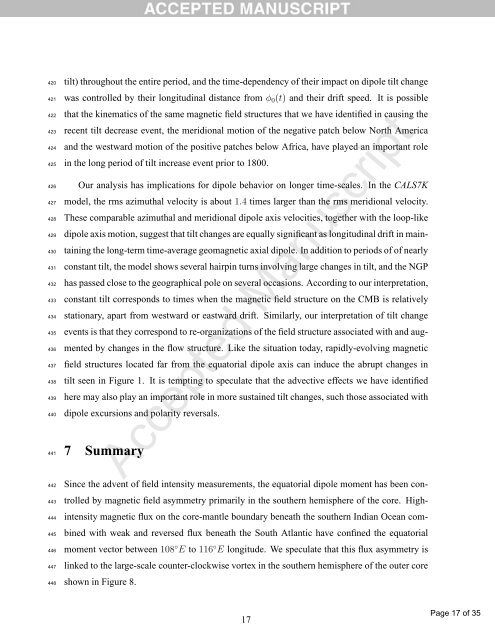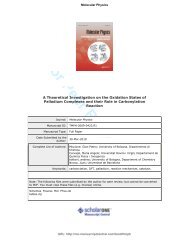Accepted Manuscript - TARA
Accepted Manuscript - TARA
Accepted Manuscript - TARA
You also want an ePaper? Increase the reach of your titles
YUMPU automatically turns print PDFs into web optimized ePapers that Google loves.
420<br />
421<br />
422<br />
423<br />
424<br />
425<br />
426<br />
427<br />
428<br />
429<br />
430<br />
431<br />
432<br />
433<br />
434<br />
435<br />
436<br />
437<br />
438<br />
439<br />
440<br />
441<br />
442<br />
443<br />
444<br />
445<br />
446<br />
447<br />
448<br />
tilt) throughout the entire period, and the time-dependency of their impact on dipole tilt change<br />
was controlled by their longitudinal distance from φ 0 (t) and their drift speed. It is possible<br />
that the kinematics of the same magnetic field structures that we have identified in causing the<br />
recent tilt decrease event, the meridional motion of the negative patch below North America<br />
and the westward motion of the positive patches below Africa, have played an important role<br />
in the long period of tilt increase event prior to 1800.<br />
Our analysis has implications for dipole behavior on longer time-scales. In the CALS7K<br />
model, the rms azimuthal velocity is about 1.4 times larger than the rms meridional velocity.<br />
These comparable azimuthal and meridional dipole axis velocities, together with the loop-like<br />
dipole axis motion, suggest that tilt changes are equally significant as longitudinal drift in maintaining<br />
the long-term time-average geomagnetic axial dipole. In addition to periods of of nearly<br />
constant tilt, the model shows several hairpin turns involving large changes in tilt, and the NGP<br />
has passed close to the geographical pole on several occasions. According to our interpretation,<br />
constant tilt corresponds to times when the magnetic field structure on the CMB is relatively<br />
stationary, apart from westward or eastward drift. Similarly, our interpretation of tilt change<br />
events is that they correspond to re-organizations of the field structure associated with and augmented<br />
by changes in the flow structure. Like the situation today, rapidly-evolving magnetic<br />
field structures located far from the equatorial dipole axis can induce the abrupt changes in<br />
tilt seen in Figure 1. It is tempting to speculate that the advective effects we have identified<br />
here may also play an important role in more sustained tilt changes, such those associated with<br />
dipole excursions and polarity reversals.<br />
7 Summary<br />
<strong>Accepted</strong> <strong>Manuscript</strong><br />
Since the advent of field intensity measurements, the equatorial dipole moment has been con-<br />
trolled by magnetic field asymmetry primarily in the southern hemisphere of the core. Highintensity<br />
magnetic flux on the core-mantle boundary beneath the southern Indian Ocean combined<br />
with weak and reversed flux beneath the South Atlantic have confined the equatorial<br />
moment vector between 108 ◦ E to 116 ◦ E longitude. We speculate that this flux asymmetry is<br />
linked to the large-scale counter-clockwise vortex in the southern hemisphere of the outer core<br />
shown in Figure 8.<br />
17<br />
Page 17 of 35
















